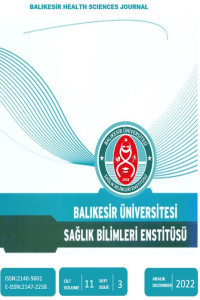İSHALLİ TAYLARDAN İZOLE EDİLEN BAKTERİLER VE ANTİBİYOTİK DUYARLILIKLARI
GİRİŞ ve AMAÇ: Taylardaki ishal vakaları ölüme kadar giden ciddi enfeksiyonlara neden olabilmektedir Bu çalışmada, ishalli taylardan bakteriyel etkenlerin izolasyonu ve izolatların bazı antibiyotiklere in vitro duyarlılıklarının belirlenmesi amaçlandı. YÖNTEM ve GEREÇLER: İshalli toplam 58 taydan fekal svap örnekleri alındı. Etkenler konvansiyonel yöntemlerle izole ve identifiye edildi.İzole edilen bakterilerin agar disk difuzyon testi ile antibiyotik duyarlılıkları belirlendi. BULGULAR: Tüm örneklerden 68 suş izole edildi. Örneklerden karışık kültür 9 (%13.23), saf kültür ise 59 (%86.76) adet üredi. Bu mikroorganizmalar içinde en fazla Citrobacter spp. (%44.11) üredi. Daha sonra sırası ile Escherichia coli (%30.88), Klebsiella oxytoca (%8.82), Staphylococcus spp. (%5.88), Micrococcus luteus (%4.41), Streptococcus zooepidemicus (%1.47), Acinetobacter calcoaceticus (%1.47) ve Pseudomonas aeruginosa (%1.47) üredi. Bu bakteriler üzerine en etkili antibiyotikler sırası ile nitrofurantoin, enrofloksasin, ampisilin-sulbactam, gentamisin ve amoksisilin-klavulanic asit olarak belirlendi. TARTIŞMA ve SONUÇ: Ekonomik olarak oldukça değerli olan tayların mutlaka ishallerinin kontrol altına alınması ve etkenin belirlenerek gerekli antibiyotik ve destek tedavisinin uygulanması oldukça önemlidir. Bu konuda daha çok yapılacak araştırmalara ihtiyaç vardır.
Anahtar Kelimeler:
Antibiyotik duyarlılığı, fekal svap
ISOLATİON OF BACTERİAL AGENT FROM DİARRHEA WİTH FOAL AND ANTİBİOTİC SUSCEPTİBİLİTY
INTRODUCTION: Diarrhea in foal can cause serious infections to death. In this study, the determination of microor-ganisms and antibiotic susceptibility of isolated bacteria in fecal swab samples collected from foals with diarrhea were aimed. METHODS: Sixty-eight strains were isolated from all of samples. The agents were isolated and identified with conventional methods. RESULTS: The organisms were isolated in pure culture from 59 (86.76%) samples and were isolated in mixed culture from 9 (13.23%) samples. Citrobacter spp. (44.11%) was the most frequently isolated agent. Also, Escherichia coli (30.88%), Klebsiella oxytoca (8.82%), Staphylococcus spp. (5.88%), Micrococcus luteus (4.41%), Streptococcus zooepidemicus (1.47%), Acinetobacter calcoaceticus (1.47%), and Pseudomonas aeruginosa (1.47%) were isolated, res¬pectively. This bacterial agents were found susceptible nitrofurantoin, enrofloxacin, ampicillin-sulbactam, gentamycine, amoxicillin-clavulanic acid, respectively. DISCUSSION AND CONCLUSION: It is very important to apply the necessary antibiotic and supportive treatment to determine the cause of the fever which is very economically valuable and to control the diarrhea. There is a need for further research in this regard.
Keywords:
Antibiotic sensitiviy test, fecal svap,
___
- 1. Lester GD. Infectious Diarrhea in Foals. Proceedings of the Annual Convention of the AAEP 2001, Vol. 47.
- 2. John J, Roediger K, Schroedl W, Aldaher N, Vervuert I.Development of intestinal microflora and occurrence of diarrhoea in sucking foals: effects of Bacillus cereus var.toyoi supplementation. BMC Ve. Res. 2015; 11(34): 2-7.
- 3. Akan M, Diker KS, Koçak C, Yıldırım M, Bozkurt Ş. Çiğ sütten hareketli aeromonas türlerinin izolasyonu. Gıda, 1996; 21(5): 383-386.
- 4. İlhan Z, Gülhan T, Aksakal A.: Aeromonas hydrophila associated with ovain abortion. Small Rumin Res. 2006; 61(1): 73-78.
- 5. Derlet RW, Carlson J. An Analysis of Human Pathogens Found in Horse/Mule Manure Along the John Muir Trail in Kings Canyon and Sequoia and Yosemite National Parks.Wilderness Environ Med. 2002; 13(2): 113–118.
- 6. Slovis NM, Elam ME, Leutenegger CM. Infectious agents associated with diarrhoea in neonatal foals in central Kentucky: A comprehensive molecular study. Equine Vet J.2014; 46: 311–316.Pass RF. Epidemiology and transmission of Cytomegalovirus. J Infect Dis 1985: 152:243.
- 7. Quinn PJ, Markey BK, Leonard FC, Fitzpatrick ES, Fanning S, Hartigan PJ. Veterinary Microbiology and Microbial Disease. Second Edit., Wiley-Blackwell, West Sussex, UK.(2011).
- 8. Gülhan T,: Sağlıklı Görünen Hayvanların Dışkılarından İzole Edilen Escherichia coli Suşlarının Biyokimyasal, Enterotoksijenik ve Verotoksijenik Özelliklerinin Belirlenmesi. YYU Vet Fak Dergi. 2003; 14(1): 102-109.
- 9. Sgorbini M, Nardoni S, Mancianti F, Rota A. Foal-Heat Diarrhea Is Not Caused by the Presence of Yeasts in Gastrointestinal Tract of Foals. J Equine Vet Sci. 2008; 28(3): 145–148.
- 10. Kuhl J, Winterhoff N, Wulf M, Schweigert FJ, SchwendenweinI, Bruckmaier RM, Aurich JE, Kutzer P, Aurich C. Changes in faecal bacteria and metabolic parameters in foals during the first six weeks of life. Vet Microbiol. 2011; 151: 321–328.
- 11. Costa MC, Stampfli HR, Allen-Vercoe E, Weese JS.Development of the faecal microbiota in foals. Equine Vet J. 2016; 48: 681–688.
- ISSN: 2146-9601
- Yayın Aralığı: Yılda 3 Sayı
- Başlangıç: 2012
- Yayıncı: Balıkesir Üniversitesi
